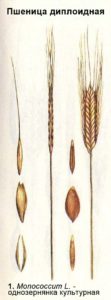What types of wheat are there: characteristics of types and varieties
Wheat (lat. Triticum) belongs to herbaceous, mainly annual plants of the Cereals family. This common grain crop is diverse - soft, hard, winter, spring, food, wild, as well as a large number of varieties. Of interest are the food varieties - spelled, spelled, maha and other representatives of this ancient cereal plant.
Types of wheat
In accordance with the classification of P. M. Zhukovsky, 4 basic genetic groups are identified wheat depending on the number of chromosomes (2n) in somatic cells.
1. Diploids (2n = 14):
- Triticum urartu - wild einkorn, known as Urartu chaff wheat, winter;
- T. boeoticum is a wild or Boeotian einkorn, predominantly winter, but spring varieties are sometimes found;
- T. monococcum is a cultivated einkorn, mainly spring, with flat ears;
- T. sinskaiae - Sinskaya hulless wheat, characterized by a high protein content.
2. Tetraploids (2n = 28):
- T. dicoccoides - wild emmer, belongs to the section of filmy species;
- T. dicoccum - common spelled, unpretentious spring crop;
- T. karamyschevii - Colchian emmer, there are spring, semi-winter and winter species of the mountain plant;
- T. ispahanicum - Isfahan spelled, belongs to the early ripening winter and spring membranous varieties;
- T. turgidum - naked turgidum wheat crop, cultivated in hot climates;
- T.jakubzineri - Yakubtsiner's semi-winter wheat;
- T. durum - durum wheat, mainly spring wheat, ranks second in the world in terms of sown area;
- T. turanicum - Turanian, cultivated in the southern regions;
- T. aethiopicum - Ethiopian, grown in the warm high mountain steppes of Ethiopia, spring;
- T. polonicum - polonicum, has no production value;
- T. persicum—Karmala wild, or spring persicum;
- T. araraticum - wild-growing Araratian emmer, drought-resistant, high protein, spring;
- T. timopheevii - Timofeev's wheat, a mountain spring plant resistant to cool climates;
- T. militinae - militina, multi-stemmed spring.
3. Hexaploids (2n = 42):
- T. macha - macha, a winter cereal from Western Georgia;
- T. vavilovii - Vavilov, drought-resistant winter;
- T. compactum - bare grain compactum wheat, early ripening; there are semi-winter, winter or spring plants with good baking properties;
- T. spelta - spelled, cultivated in limited quantities;
- T. aestivum - soft wheat, there are semi-winter, winter and spring cereals, this is the most common grain crop on all continents;
- T. sphaerococcum - spherical, not currently cultivated;
- T. petropavlovskyi - Petropavlovsky, heat-tolerant culture;
- T. zhukovskyi - Zhukovsky, a spring variety with good baking characteristics;
- T. kiharae - membranous kihara, has high immunity to fungal infections;
- T. miguschavae - Migusheva, resistant to fungal diseases.
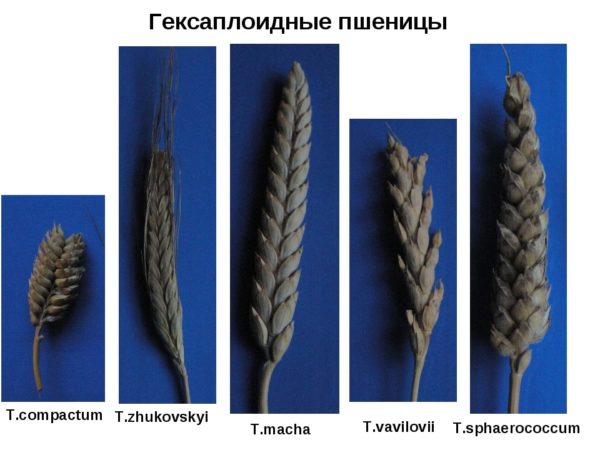
4. Octoploids (2n = 56):
- T. timonovum - timonovum wheat, spring, with high protein concentration and nutritional value;
- T. fungicidum is a fungal, spring variety for cool climates.
Classification of wheat varieties
Among the variety of crop types, several varieties are distinguished. Let's look at what wheat is like.
Spelled
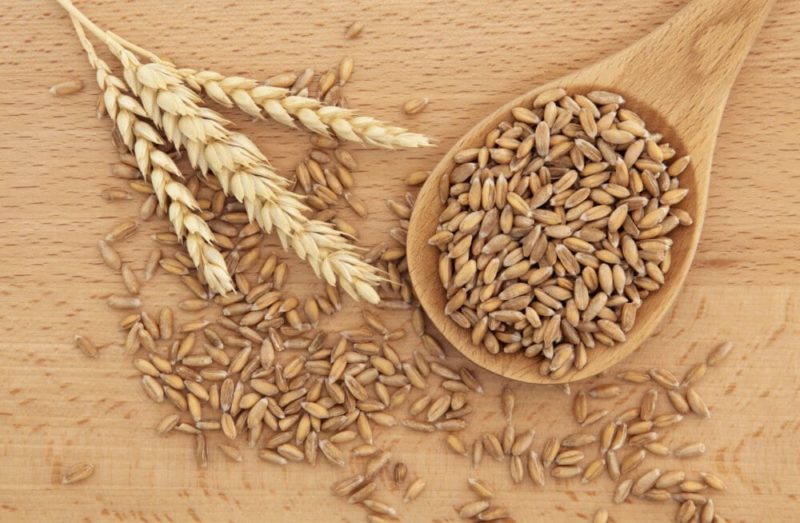
Spelled wheat (Triticum spelta) belongs to the section of chaffy spring or winter, rarely cultivated varieties of wheat of the hexaploid group. Prefers moist mountain areas.
It is characterized by average winter hardiness, unpretentiousness, and a significant protein concentration (about 25%). The disadvantages include low productivity, susceptibility to diseases, and difficult grain threshing.
Esaul
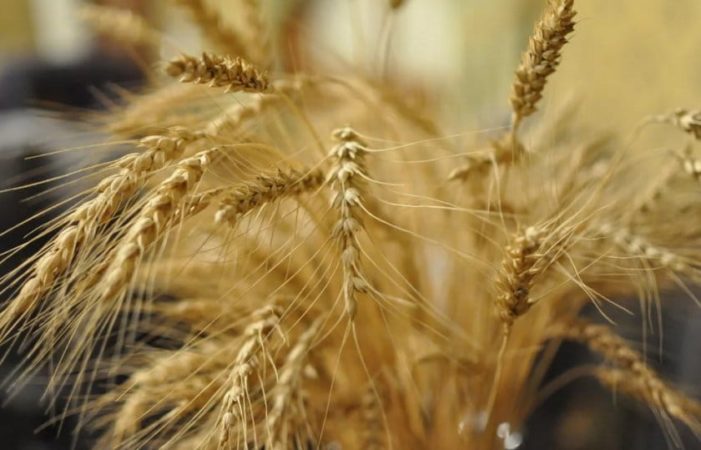
Ultra-early ripening Esaul belongs to the varieties of Erythrospermum soft wheat of the hexaploid group. The winter variety is included in the State Register for cultivation in the North Caucasus.
Esaul wheat is characterized by high yield (up to 82.5 c/ha), resistance to diseases, drought and lodging. Grain indicators are typical for a “strong” crop: protein content - 11–17%, gluten free — 28–32%.
Arizona
In the deserts of Arizona, a large number of plantain seeds accumulate, resembling loaves of bread in appearance.
They are called “Arizona wheat,” although they are not a cereal crop.
Dwarf
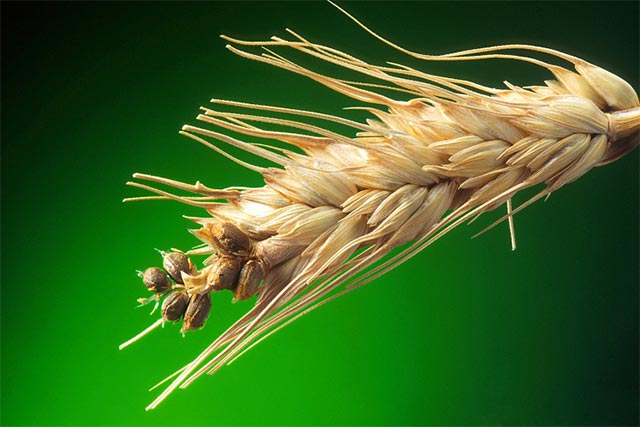
The oldest early ripening species Triticum compactum belongs to the membranous types of the Triticum section of the hexaploid group. The characteristics of dwarf wheat are identical to soft wheat.
It is rarely cultivated, although it has a high protein content (16–19%), good baking properties, and low lodging. Disadvantages - susceptibility to fungal infections, low productivity (up to 16–20 c/ha).
Continental
Spring soft wheat Continental from the hexaploid group is valued for its excellent baking characteristics, resistance to lodging and diseases, and good yield (38–50 c/ha).
Cherkizovskaya
The Cherkizovo agro-industrial company cultivates high-yielding varieties of winter and spring wheat, introduces new technologies for soil cultivation and fertilizing crops.
Sowing
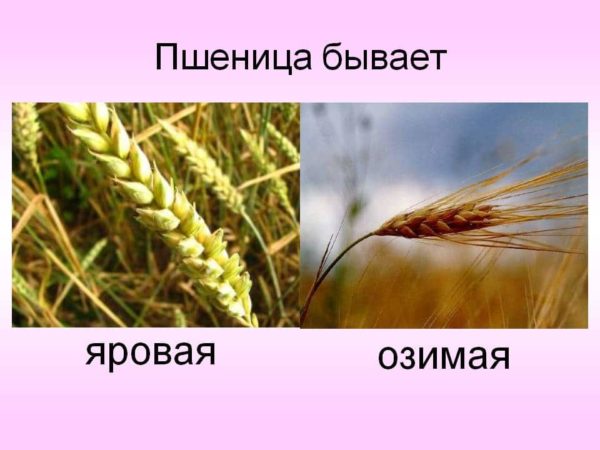
There are 2 types of wheat seed crop:
- Yarovaya. It is planted in the spring. Most common in areas with cold winters. On average, ripening lasts 98–105 days.
- Winter. Sow before winter. The harvest, which is higher than that of a spring crop, ripens in the summer.
Food
According to this indicator, wheat is divided into 2 types:
- Soft. It is distinguished by the unbreakable shaft of an elongated, loose spike, which can be either awnless or with short awns diverging on the sides. The rounded bare grain at the break is often mealy rather than glassy. The straws are hollow. Meet spring and winter varieties.
- Solid. Unbreakable stem of a dense ear with parallel long awns. The angular bare grain at the fracture is glassy. The straw inside is filled at the top or with a small gap. Mainly solid types include spring varieties, but there are also winter crops.
Food
Wheat used for food (food) is divided according to GOST 9353-2016 into 5 classes depending on color, smell, glassiness, gluten and protein content.
Reference! The most valuable is class 1 grain, in which the share of gluten is 32% for soft types and 28% for hard types, and protein is 14.5% and 13.5%, respectively. These indicators are not limited to grade 5.
Wheat of the first 3 classes is used as raw material for the baking industry. Species belonging to the fourth and fifth classes are used for the production of pasta and cereal products.
Differences between wild, semi-wild and food wheat
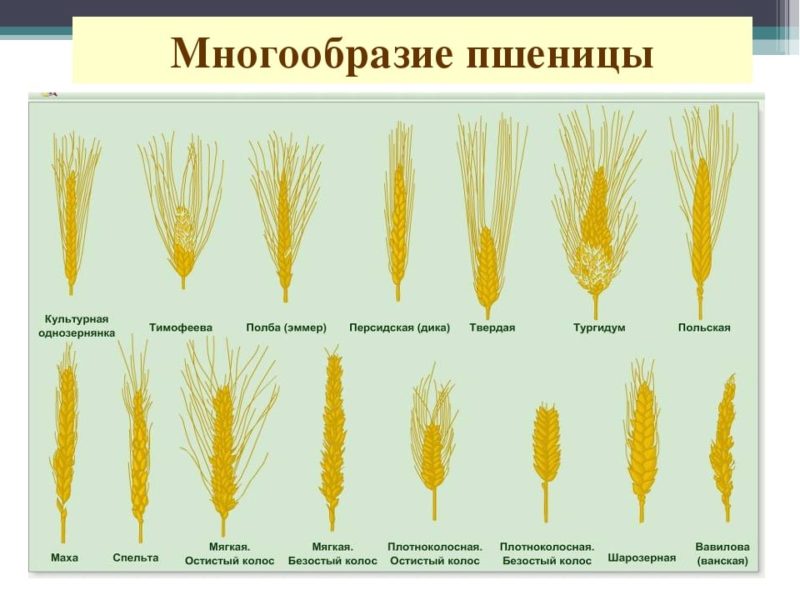
The main characteristic of wild wheat is the shedding of grains after ripening. It is difficult to harvest such a crop, so previously these grains were consumed in an unripe state.
Domestication in the direction of increasing strength ears of corn At first it was spontaneous in nature, but as breeding research developed, the selection of semi-wild varieties with larger, non-shattering grains and resistance to lodging continued.
The grain of a modern cultivated cereal requires threshing to be released from the spikelets. Its chemical composition has also changed: wild (spelt) and semi-wild (spelt) wheat contains more useful compounds, fatty acids and protein than food types.
Wheat varietal characteristics
To determine the grade of a crop, several basic characteristics are used:
- ear shape - cylindrical, fusiform, club-shaped and slightly club-shaped;
- ear density - determined by the ratio of the number of spikelets to the length of the rod;
- characteristics of the spines - thin, coarse, intermediate;
- length and shape of the teeth of the spikelet scales - beak-shaped, blunt, sickle-shaped, pointed;
- scale shape - ovoid, oval, lanceolate, oval-lanceolate and ovate-lanceolate;
- the shoulder of the scales is beveled, straight, raised, the width can be narrow, wide, medium;
- grain shape - ovoid, oval, barrel-shaped;
- degree of phenol staining of grains - intense, weak, absent.
Donors of resistance to bunt in wheat
In breeding, it is important to select varieties as donors that demonstrate high resistance to such a dangerous fungal disease as smut.
According to research results, the following wheat varieties with a high degree of resistance to the fungus are distinguished:
- hard winter - Krucha;
- soft two-handed - Anka;
- soft winter - Adele, Dolya, Urup;
- spring triticale - 188 Yarik.
Good resistance to the dangerous pathogen is noted in the winter soft varieties Pamyati Fedina, Galina, Knyaginya Olga, Inna, Smuglyanka. This list includes Moskovskaya 40, Columbia, Imprompt, Bezenchukskaya 380.
List of the best wheat varieties
Promising varieties with high productivity and other positive characteristics are identified.
Soft winter wheat:
- Alekseich. A mid-season, lodging-resistant variety under favorable conditions produces up to 120 c/ha of yield.
- Timiryazevka 150. A bushy, strong cereal crop produces a yield of up to 96–138 c/ha. It has high immunity to diseases and is resistant to drought and low temperatures.
- Lilith. The variety, resistant to shedding, moisture deficiency, lodging, and diseases, produces up to 100–110 c/ha of grain.
- Bezostaya 100. Attracts with drought and frost resistance. Does not lie down, is slightly affected by diseases. Productivity - 70–100 c/ha.
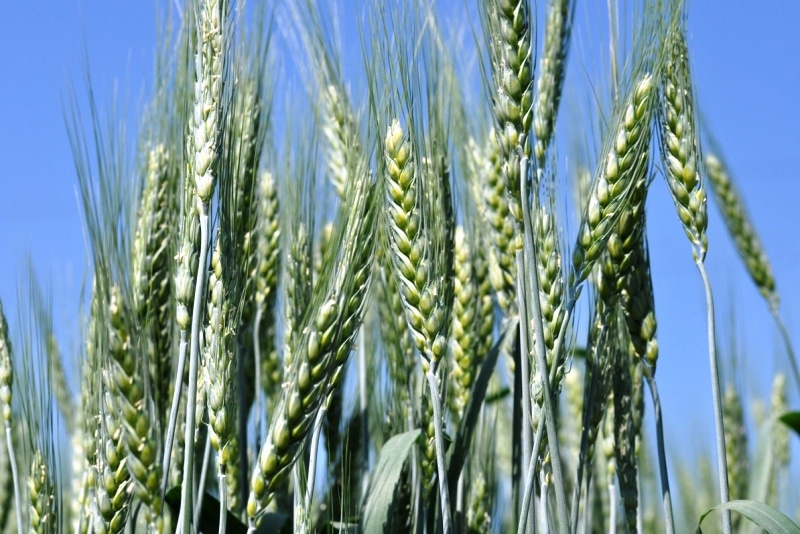
Soft spring wheat:
- Omsk. Round-oval large grains with high baking characteristics. The mid-season crop (ripens in 88–90 days) is resistant to drought, disease, and lodging. Productivity - up to 60–65 c/ha.
- Boyevchanka. Elongated, large, oval-shaped grains contain a large amount of gluten (above 40%). The cereal is used in the baking industry. The culture does not lodge, is resistant to diseases and changeable weather conditions.The average yield is 50–55 c/ha.
- Uralosibirskaya. A grain crop with a yield of 44–50 c/ha ripens on average 90 days after sowing. Resistant to diseases, sudden temperature changes, and lodging.
Durum spring wheat:
- Triad. A mid-late crop, resistant to diseases and lodging, produces a yield of up to 90 c/ha.
- Omsk amber. A mid-season variety with weak lodging demonstrates high resistance to diseases and cold weather. Easily threshed. Productivity - 60–70 c/ha.
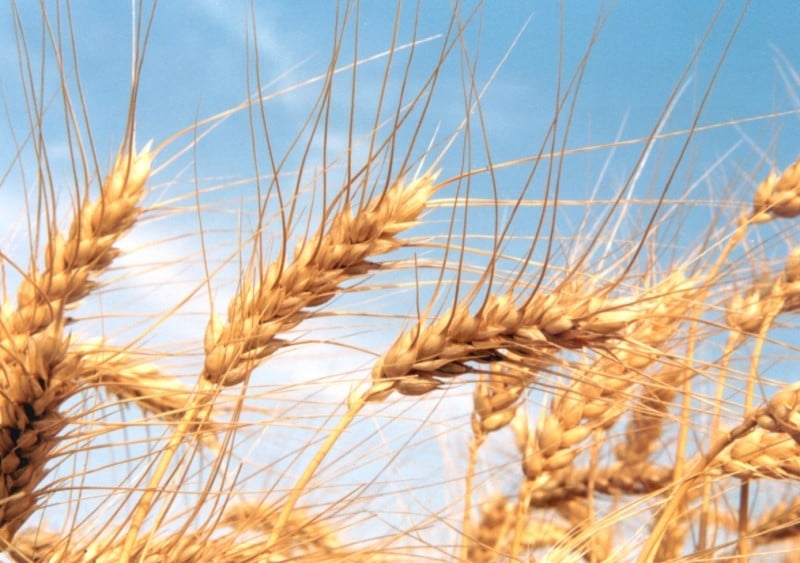
One of the best hard winter varieties is Krupinka. A mid-season, short-growing crop with high immunity to disease and drought, it is highly productive: it produces up to 91 c/ha of grain.
Conclusion
Wheat is a unique type of cereal crop, used not only as food and technical products, but also as feed products. Breeders are gradually developing new varieties with immunity to dangerous plant diseases, resistant to lodging and adverse weather conditions.
